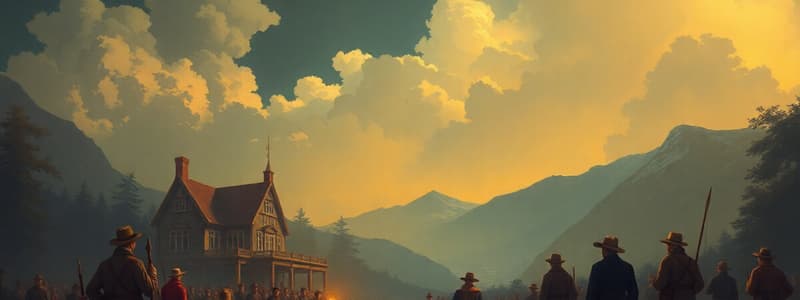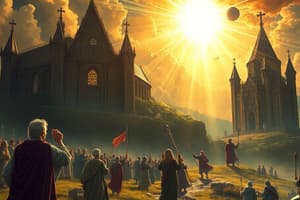Podcast
Questions and Answers
Which group was the largest Protestant denomination during the Second Great Awakening?
Which group was the largest Protestant denomination during the Second Great Awakening?
- Congregationalists
- Presbyterians
- Baptists
- Methodists (correct)
The Second Great Awakening only attracted white individuals to its revivals.
The Second Great Awakening only attracted white individuals to its revivals.
False (B)
What was the primary goal of the Temperance Movement?
What was the primary goal of the Temperance Movement?
To promote abstinence from alcohol.
The year _____ marked the formation of the American Temperance Society.
The year _____ marked the formation of the American Temperance Society.
Match the following Protestant denominations with their growth during the Second Great Awakening:
Match the following Protestant denominations with their growth during the Second Great Awakening:
How much alcohol did the average American consume per year in 1825?
How much alcohol did the average American consume per year in 1825?
The 'Cult of Domesticity' emphasized women's roles as household caretakers.
The 'Cult of Domesticity' emphasized women's roles as household caretakers.
Name one major event that exemplified the outdoor camp meetings during the Second Great Awakening.
Name one major event that exemplified the outdoor camp meetings during the Second Great Awakening.
Which of the following statements reflects the double standard in beliefs about sexuality?
Which of the following statements reflects the double standard in beliefs about sexuality?
The doctrine of separate spheres arose as a result of industrialization, which divided home life from business life.
The doctrine of separate spheres arose as a result of industrialization, which divided home life from business life.
What was the main argument of William Lloyd Garrison regarding the abolition of slavery?
What was the main argument of William Lloyd Garrison regarding the abolition of slavery?
The practice of wanting to settle freed slaves in colonies in Africa is known as __________.
The practice of wanting to settle freed slaves in colonies in Africa is known as __________.
Match the following beliefs with their corresponding aspects of the abolition movement:
Match the following beliefs with their corresponding aspects of the abolition movement:
Which career became the primary option for women as a result of industrialization?
Which career became the primary option for women as a result of industrialization?
The early abolition movement was characterized by immediate emancipation of enslaved people.
The early abolition movement was characterized by immediate emancipation of enslaved people.
Name one hardship that was brought about by slavery according to abolitionist beliefs.
Name one hardship that was brought about by slavery according to abolitionist beliefs.
Flashcards
Second Great Awakening
Second Great Awakening
A period of widespread religious revival across the United States in the early 19th century.
Camp Meetings
Camp Meetings
Outdoor gatherings that lasted for days where people listened to preachers and sought religious revival.
Simple Message of Salvation
Simple Message of Salvation
The belief that individuals could achieve salvation through personal faith and devotion, regardless of their social status.
Temperance Movement
Temperance Movement
Signup and view all the flashcards
Cult of Domesticity
Cult of Domesticity
Signup and view all the flashcards
Abstinence
Abstinence
Signup and view all the flashcards
American Temperance Society
American Temperance Society
Signup and view all the flashcards
Reduced Alcohol Consumption
Reduced Alcohol Consumption
Signup and view all the flashcards
Women's Moral Superiority
Women's Moral Superiority
Signup and view all the flashcards
Double Standard in Sexuality
Double Standard in Sexuality
Signup and view all the flashcards
Doctrine of Separate Spheres
Doctrine of Separate Spheres
Signup and view all the flashcards
Decline of Women's Careers
Decline of Women's Careers
Signup and view all the flashcards
Gradual Emancipation
Gradual Emancipation
Signup and view all the flashcards
Colonization
Colonization
Signup and view all the flashcards
Compensation
Compensation
Signup and view all the flashcards
New Abolition Movement
New Abolition Movement
Signup and view all the flashcards
Study Notes
Revivalism and Reform
- Religious revivals swept the nation, particularly impacting Protestant denominations like Baptists and Methodists
- Camp meetings, lasting days, drew large crowds (e.g., 10,000 people at Cane Ridge, Kentucky in 1801)
- Revivals emphasized personal salvation and religious experience, attracting people from all social backgrounds (men, women, white, African American, and Native American)
- The Second Great Awakening spurred growth in evangelical Protestantism, including Baptists, Presbyterians, Congregationalists, and Methodists.
- Church attendance increased significantly by mid-1840s.
Temperance Movement
- Americans consumed significantly more alcohol per adult than today (7 gallons/year in 1825, compared to a much lower amount today)
- Alcohol abuse led to societal problems like poverty and violence.
- Temperance Societies were created with pastors urging members to abstain from alcohol
- These groups encouraged abstinence and preached about the negative impacts of alcohol on the soul
- The American Temperance Society was formed in 1826, and by 1836, local temperance groups grew to 5,000
- These movements successfully decreased overall alcohol consumption to under 2 gallons per year by 1845.
Family Life
- The "Cult of Domesticity" emerged in the first half of the 19th century, emphasizing women's role as homemakers and caregivers, in charge of the household.
Studying That Suits You
Use AI to generate personalized quizzes and flashcards to suit your learning preferences.
Related Documents
Description
Explore the movements of revivalism and temperance in America, focusing on the Second Great Awakening and the societal impact of alcohol consumption. Understand how these religious revivals influenced various demographic groups and led to the formation of temperance societies. This quiz delves into a transformative period in American history.




